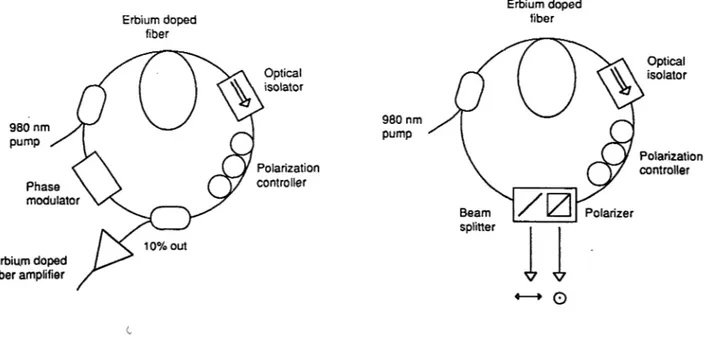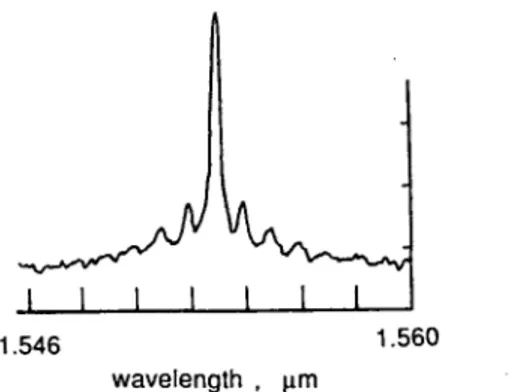Pdll
Polarization Mode Locking in Erbium Doped Fiber Ring Lasers
M. Romagnoli, A. Tajani, M. Tamburrini, S . Wabnitz, B. Daino Fondazione Ugo Bordoni, Via B . Castiglione 59,00/42 Roma, Italy
F. Fontana, N. Manfredini, G. Grasso Societd Cavi Pirellli , Viale Sarca 2,20126 Milano, Italy
P. Franco, M. Midrio
Dipartimento di Elettronica ed Infomtica, Universita di Padova, Via Gradenigo 6lA, 35131,
Padova, Italy
liztroduction: Mode-locking (ML) with erbium doped fiber lasers permits to combine the wide
spectral bandwidth of the gain medium with the anomalous group velocity dispersion of the fiber. As a result, soliton pulse shaping plays a key role in the ML dynamics [l-21. By combining ultrashort soliton amplification and soliton switching [3], it has been demonsrrated that ML erbium doped fiber lasers may operate in the femtosecond regime [4]. These ML sources are inmnsically self-starting and unstable [ 5 ] , and the origin of the observed complex temporal behavior has been recently ascribed to soliton resonances with the laser cavity length 161.
In this work we present results of experimental studies of the role of polarization rotation as a
switching mechanism [7] in both active and passive ML in erbium doped fiber ring lasers. In the
active case, by controlling the state of polarization we observed the generation of ML 100
femtosecond pulse trains, with repetition raies as high as 300 GHz. In the passive case, ML is self-starting and we observed the generation of multiple pulses with different wavelengths and polarization states
[8].
Here the control of the state of polarization permits the selection of the output wavelengths.Experiment: The experimental configurations for active and passive ML in erbium doped fiber ring
lasers are shown in fig.(l). In both cases, gain is provided by a 10 m long erbium doped fiber (aluminium codoped), with the numerical aperture NA = 0.2, and the absorption of 5.5 dB/m at
the wavelength h = 1532 nm. Whereas the cutoff wavelength is 900 nm, which permits single mode propagation of the 980 nm pump from a dichroic coupler. The maximum power from the semiconductor pump laser was equal to 39 mW. Unidirectional operation was ensured by means of a polarization insensitive optical isolator. Active ML was initiated by LiNb03 phase modulator, and the state of polarization &ter the isolator was manipulated by means of an all-fiber polarization controller. In the passive case, a bulk polarizing beam splitter was employed in order to reject one
391
P d l l
polarization component (vertical) from the cavity. Whereas in the active case polarization discrimination was achieved through a directional coupler. In the passive configuration, we also monitored the polarization state inside the cavity (horizontal) by means of a beam sampler. In either case, the average output power from the lasers ranged from 0.2 to 2 mW. The output light was detected with fast photodiodes and sampling oscilloscopes, which in some cases pexmitted to directly measure the repetition rate of the circulating trains. In the femtosecond ML regime, we have performed autocorrelations of the output pulse trains after an erbium do@ fiber amplifying stage (with a linear gain of 20 dB).
Results: In the active case, as the modulator was tumed on the cw laser oscillation broke up into a
regular train of ML pulses. The repetition rate of the train was equal to the fundamental frequency of the cavity (7.5 MHz), irrespectively to some extent of the modulation frequency. The time duration of the ML train in the envelope was 5 ns. Figure (2) shows the autocorrelation of the ML pulses, which reveals the 100 fs full width of the pulses (possibly time compressed along the amplifíer). The inset in figure (1) shows that the repetition rate of the ML train was as high as 300 GHz. The control of the state of polarization in the ring was critical for obtaining ultrashort pulse
ML. Nevertheless, once it was achieved the ML was relatively stable.
In the passive case, self-starting ML was observed to prevail over cw oscillation. The temporal characteristics of the generated pulses consisted of a superposition pulses circulating at the fundamental cavity frequency and at higher harmonics. Therefore we have characterized the laser output in the spectral domain. We found that the laser tends to mode lock pulses with different wavelengths and polarizations. Figure (3) shows a case of single-frequency emission, which is accompanied by several satellite sidebands. From the main spectrum of fig.(3) we infer a ML pulse width of the order of 30 ps, which would rule out the soliton resonances with the loop length [6] as a possible mechanism for sideband generation. Moreover, here the sidebands are equally spaced whereas soliton resonance leads to wavelength separations that
are
proportional to the square rmt of the sideband order [ 6 ] .Figure (4) shows dual-frequency ML in the passive ring laser. Here we have removed the polarizer since only the beam splitter introduces polanzation sensitive losses in the cavity. The polarization decomposition that is shown in fig.(4) follows the directions which are either parallel or orthogonal to the entry plane of incidence of the splitter. As it can be seen, the polarization state
of the two peaks is different. Moreover, the sidebands only appear in one polarization. The observed anisotropy disappears reducing the pump power.
ML was not only limited to pulses with two different frequencies. By simply rotating the polarization controller, it was possible to introduce several polarized optical paths in the cavity which leads to multiple frequency ML (see fig.(5)) 181.
I
Pdll
Conclusions: We have studied polarization induced passive and active ML in a simple erbium
doped fiber ring laser configuration. In the active case, we have demonstrated the generation of ultrahigh repetition rate femtosecond pulse trains. In the case of self-stanzing passive ML, we have revealed the generation of polarized sidebands and multiple fiequency Ma.
Acknowledgements: This work was camed out in the framework of the agreement between Fondazione Ugo Bordoni and the Italian P.T. Administration.
References
[ 11 J. D. Kafka, T. Baer, and D. W. Hall, Opt. Lett. 14, 1269 (1989).
[2] K. Smith, J. R. Armitage, R. Wyatt, and N. J. Doran, Electron. Leu. 26, 1149 (1990). [3] A. G. Bulushev, E. M. Dianov, and O. G. Okhotnikov, Opt. Lett. 15,968 (1990). [4] I. N. Duling, Electron. Lett. 27, 544 (1991).
[5] R. P. Davey, N. Langford, and A. I. Ferguson, Electron. Lett. 27, 1257 (1991); D. J. Richardson, R. I. Laming, D. N. Payne, V. J. Matsas, and M. W. Phillips, Electron. Lett. 27,
1451 (1991).
[ 6 ] N. Pandit, D. U. Noske, S. M. J. Kelly, and J. R. Taylor, Electron. Letters 28,455 (1992). [7] M. Hofer, M. E. Femmann, F. Haberl, M. H. Ober, and A. J. Schmidt, Opt. Lett. 16, 502 (1991).
[8] J. B. Schlager, S. Kawanishi, M. Saruwatari, Electron. Lett. 27, 2073 (1991).
Active conf iguration
Se I
f
-
st arti ng
co n
f
ig
u rat
io
n
Erbium doped fibar 980 nm PumP Erbium doped fiber optical
/j’
UYisoiator
Polarizatior controller Beam Y X Z C r i z e r splitterI
I
IFigure 1: Schematic of active and passive polarization mode-locking with erbium doped fiber ring lasers.
393
P d l l
u
time delay (0.16 ps/div)
Figure 2: Autocorrelation of 100 fs output pulse from actively mode locked erbium fiber ring laser. The inset shows the autocorrelation of the pulse train with 3 ps repetition rate.
1.546 1.560
wavelength , pm
Figure 3: Multiple sideband generation from self-starting passive mode locked laser.
-
1.557 1.563 wavelength , p mu
1.553 1.559 wavelength , pm Figure 4: Polarization decomposition of dualfrequency passive mode locking at high pump p o w er s.
Figure 5 : Birefringence-controlled triple
frequency passive mode locking.

